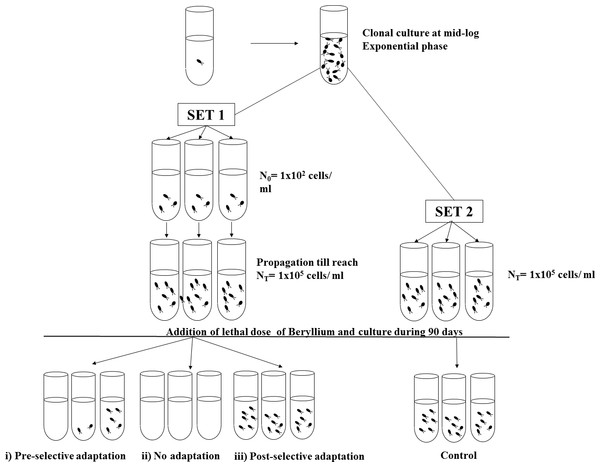
The current biodiversity crisis represents a historic challenge for natural communities: the environmental rate of change exceeds the population's adaptation capability. Integrating both ecological and evolutionary responses is necessary to make reliable predictions regarding the loss of biodiversity. The race against extinction from an eco-evolutionary perspective is gaining importance in ecological risk assessment. Here, we performed a classical study of population dynamics—a fluctuation analysis—and evaluated the results from an adaption perspective. Fluctuation analysis, widely used with microorganisms, is an effective empirical procedure to study adaptation under strong selective pressure because it incorporates the factors that influence demographic, genetic and environmental changes. The adaptation of phytoplankton to beryllium (Be) is of interest because human activities are increasing the concentration of Be in freshwater reserves; therefore, predicting the effects of human-induced pollutants is necessary for proper risk assessment. The fluctuation analysis was performed with phytoplankton, specifically, the freshwater microalgae Chlamydomonas reinhardtii, under acute Be exposure. High doses of Be led to massive microalgae death; however, by conducting a fluctuation analysis experiment, we found that C. reinhardtii was able to adapt to 33 mg/l of Be due to pre-existing genetic variability. The rescuing adapting genotype presented a mutation rate of 9.61 × 10−6 and a frequency of 10.42 resistant cells per million wild-type cells. The genetic adaptation pathway that was experimentally obtained agreed with the theoretical models of evolutionary rescue (ER). Furthermore, the rescuing genotype presented phenotypic and physiologic differences from the wild-type genotype, was 25% smaller than the Be-resistant genotype and presented a lower fitness and quantum yield performance. The abrupt distinctions between the wild-type and the Be-resistant genotype suggest a pleiotropic effect mediated by an advantageous mutation; however, no sequencing confirmation was performed.
from #MedicinebyAlexandrosSfakianakis via xlomafota13 on Inoreader http://ift.tt/25f6tIU
via
IFTTT
Δεν υπάρχουν σχόλια:
Δημοσίευση σχολίου